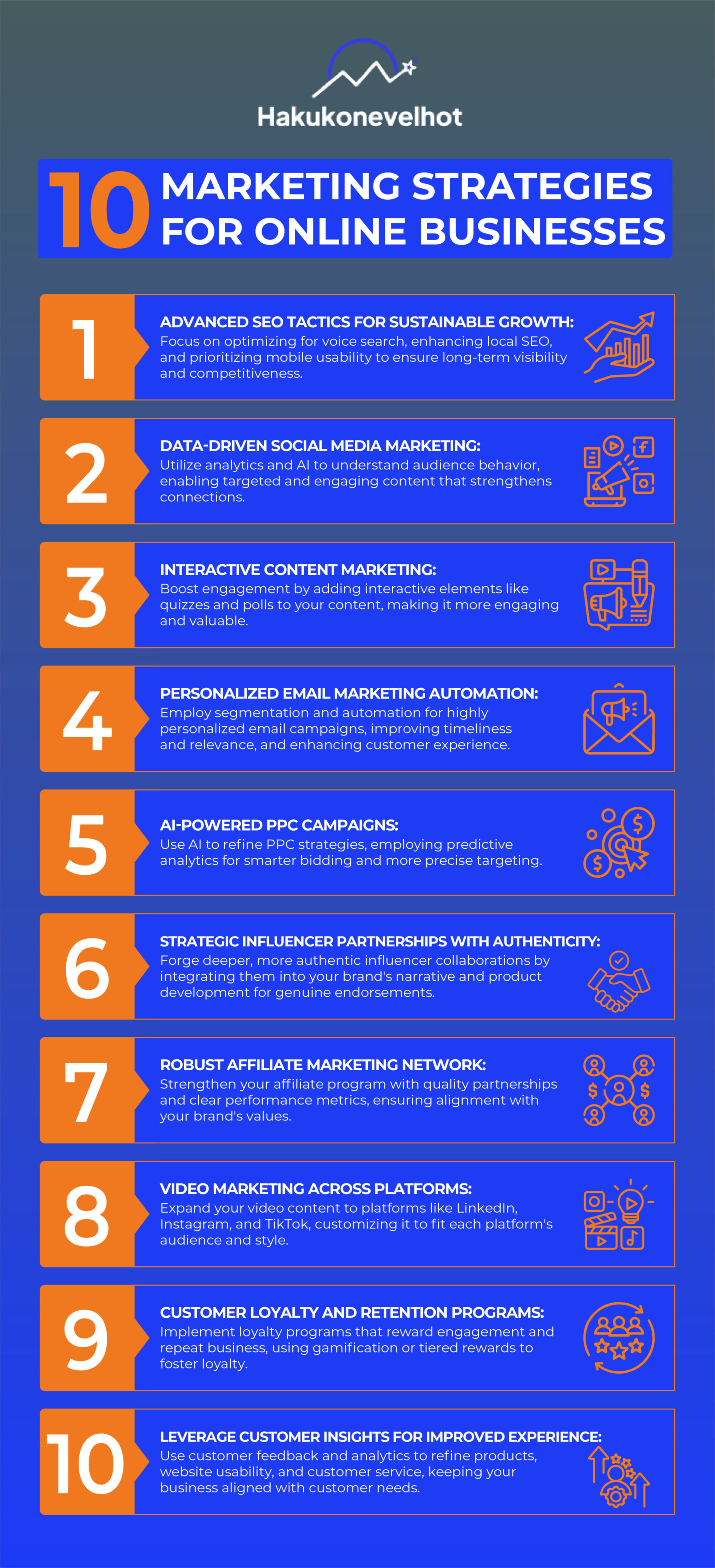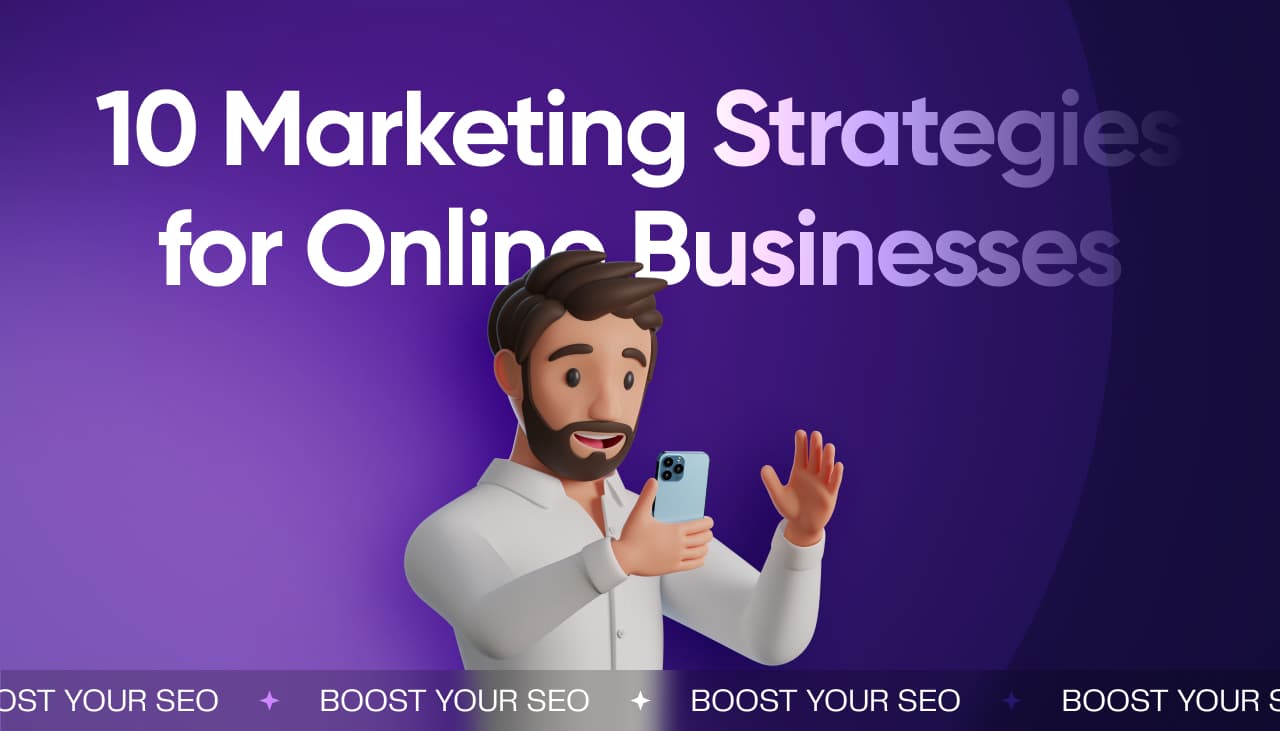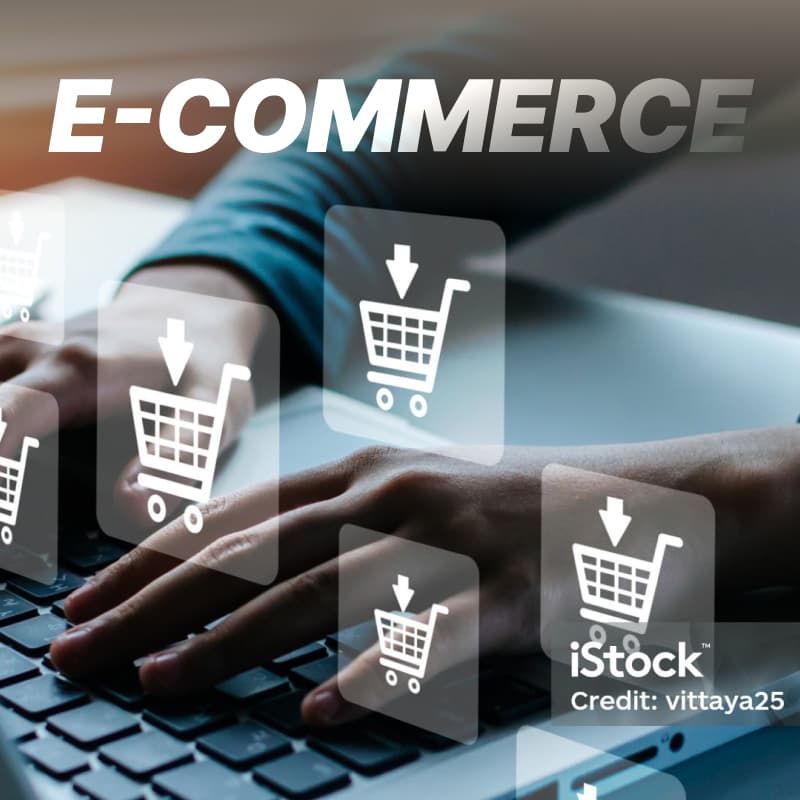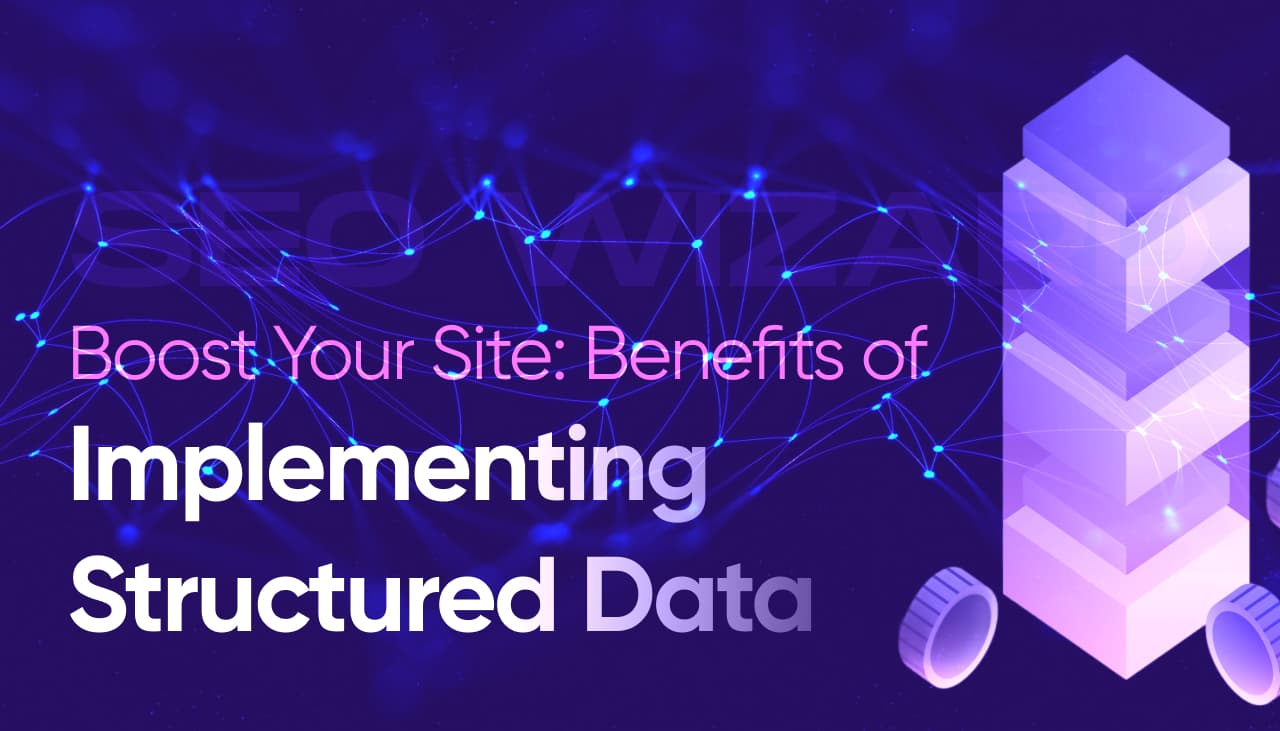In today’s fiercely competitive digital landscape, having a solid online marketing strategy isn’t just beneficial; it’s essential for small businesses looking to thrive. We understand that navigating the vast sea of digital marketing tactics can be daunting, especially when you’re a small business owner trying to figure out where to start with limited resources. That’s why we’ve compiled this guide of 10 proven online marketing strategies specifically tailored for small businesses to help you cut through the noise and connect with your target audience effectively.
That’s where we come in, ready to demystify the process and set you on the path to success. Our goal is to provide you with actionable, cost-effective strategies that can be implemented even with a small team and limited budget. By the end of this article, you’ll have a clear roadmap for launching and optimizing your online marketing efforts to drive sustainable growth for your small business.
At the heart of any thriving small business is a marketing strategy that aligns with its core values, goals, and target audience. It’s not just about throwing ideas at the wall and seeing what sticks. Instead, it’s about carefully selecting and implementing a mix of digital marketing tactics that work together synergistically to maximize your online presence and ROI. For small businesses, this often means focusing on high-impact, low-cost strategies that can be scaled as your business grows.
It’s about carefully selecting the right mix of digital marketing tools and strategies to craft a plan that not only reaches but resonates with your target audience in the online space. This includes optimizing your website for search engines (SEO), creating valuable content, leveraging social media, utilizing email marketing, and more. Each of these elements plays a crucial role in a comprehensive online marketing strategy. Let’s dive into how we can make that happen together, exploring 10 key online marketing strategies that can help your small business thrive in the digital age.
10 Marketing Strategies – infographic

Key Takeaways
- A comprehensive marketing strategy integrates advanced SEO tactics like voice search optimization, local SEO, and mobile usability to cater to evolving digital behaviors for sustainable growth.
- Leveraging data-driven insights in social media marketing through analytics platforms aids in refining strategy and enhancing audience engagement by creating targeted content based on demographic and behavior analysis.
- Interactive content marketing, through quizzes and polls, enhances user engagement by providing value and fostering active participation, significantly boosting engagement rates and
🛟 Need help with your marketing strategy?
Petteri Pucilowski, SEO consultant of Hakukonevelhot (Search engine Wizards), has 15 years of experience navigating the complex field of digital marketing. If you need help with your marketing strategy, please don’t hesitate to book an intro call with us. We offer SEO services and digital marketing services to small and medium sized businesses.
1. Advanced SEO Tactics For Sustainable Growth
In today’s rapidly evolving digital landscape, we’ve identified key areas where small businesses can focus to ensure their SEO strategies bolster long-term growth and visibility. These tactics are particularly effective for small businesses as they require more effort than budget, allowing you to compete with larger companies on a more level playing field.
Voice search optimization, local SEO, and mobile usability stand out as crucial components for a robust marketing approach, especially for small businesses looking to capture local markets and mobile users. Let’s explore each of these tactics in detail and see how you can implement them to boost your online presence.

Voice Search Optimization
Voice search has surged in popularity, thanks to the proliferation of smart speakers and virtual assistants. For small businesses, optimizing for voice search can be a game-changer, allowing you to capture local queries and compete with larger companies in specific niches.
Voice search has surged in popularity, thanks to the proliferation of smart speakers and virtual assistants.
We understand the importance of optimizing for this trend, as 50% of all online searches will be voice searches by 2023, according to ComScore. To capitalize on this, we ensure our content answers the direct questions our audience is asking. For small businesses, this means focusing on local voice searches, which often include phrases like ‘near me’ or ‘in [city name]’. By optimizing for these types of queries, you can increase your chances of being the top result for voice searches in your local area.
Utilizing long-tail keywords and structuring content in a question-and-answer format enhances our chances of appearing in voice search results. For example, if you run a local bakery, you might optimize for queries like ‘Where can I find the best cupcakes in [your city]?’ or ‘What are the hours of [your bakery name]?’. This approach not only improves your voice search visibility but also helps you create content that directly addresses your customers’ needs and questions.
Enhancing Local SEO
Local SEO is non-negotiable for small businesses operating physical locations or serving specific geographic areas. It’s a powerful tool that allows you to compete with larger companies by focusing on your local market. By optimizing for local search, you can ensure that your business appears in front of potential customers who are searching for products or services in your area.
Local SEO is non-negotiable for businesses operating physical locations or serving specific geographic areas.
We’re focused on optimizing our Google My Business listings and ensuring NAP (Name, Address, Phone Number) consistency across all online platforms. 46% of all Google searches are looking for local information, highlighting the importance of local SEO in our strategy. For small businesses, this presents a significant opportunity. By claiming and optimizing your Google My Business listing, you can improve your visibility in local search results, Google Maps, and the local pack (the map and business listings that appear at the top of search results for local queries).
Tailoring content to local events, news, and landmarks can also boost our visibility in local search results. For small businesses, this could mean creating blog posts about local events you’re participating in, sharing news about your community involvement, or highlighting how your products or services relate to local landmarks or traditions. This not only improves your local SEO but also helps build a stronger connection with your local customer base.
Prioritizing Mobile Usability
With mobile devices driving approximately 52% of global internet traffic, our website’s mobile usability is a priority. Google’s mobile-first indexing means our site’s mobile version will primarily determine our search rankings. For small businesses, having a mobile-friendly website is no longer optional—it’s essential. Not only does it improve your search rankings, but it also ensures a better user experience for the majority of your visitors who are likely accessing your site on mobile devices.
With mobile devices driving approximately 52% of global internet traffic, our website’s mobile usability is a priority. Google’s mobile-first indexing means our site’s mobile version will primarily determine our search rankings.
We conduct regular mobile usability tests to ensure speedy load times, intuitive navigation, and accessible design. This not only helps us rank higher but also improves user experience, keeping our audience engaged and reducing bounce rates. For small businesses, improving mobile usability doesn’t have to be complicated or expensive. Start by using Google’s Mobile-Friendly Test tool to identify any issues. Then, focus on implementing responsive design, optimizing images for faster loading, and simplifying your navigation for smaller screens. These steps can significantly improve your mobile user experience and, consequently, your search rankings.
By focusing on these advanced SEO tactics—voice search optimization, local SEO, and mobile usability—we’re not just chasing short-term wins but building a foundation for sustainable growth. For small businesses, these strategies offer a cost-effective way to improve online visibility and compete with larger companies. They allow you to target specific, high-intent audiences, whether they’re using voice search to find local businesses, searching for services in your area, or browsing on their mobile devices.
Our approach is always evolving to meet the changing landscape of digital marketing, ensuring we stay ahead of the curve and remain visible to our target audiences. For small businesses, this means staying informed about the latest SEO trends and being willing to adapt your strategies. Consider setting aside time each month to review your SEO performance, learn about new developments in search algorithms, and adjust your tactics accordingly. This ongoing optimization process will help you maintain and improve your search rankings over time, driving sustainable growth for your business.
2. Data-driven Social Media Marketing

In today’s digital age, leveraging data-driven insights is key to refining our social media marketing strategies. For small businesses, this approach is particularly valuable as it allows you to make the most of your limited resources by focusing on the tactics and platforms that yield the best results for your specific audience and goals.
We understand the importance of knowing our audience and how they interact with our content across various platforms. For small businesses, this means identifying which social media platforms your target audience uses most frequently and understanding their behavior on these platforms. Are they more likely to engage with video content or text posts? Do they prefer informative content or behind-the-scenes glimpses of your business? By answering these questions through data analysis, you can tailor your content strategy to maximize engagement and reach.
Use tools to analyze your social media analytics
By utilizing tools like Social Analytics, we can monitor metrics across Facebook, LinkedIn, and Instagram accounts, providing us with a high-level overview of follower growth, engagement, and more. For small businesses, there are several affordable or even free tools available that can provide valuable insights. For example, each social media platform offers its own native analytics tools, which can be a great starting point. Tools like Hootsuite, Buffer, or Sprout Social offer more comprehensive analytics across multiple platforms, often with pricing plans suitable for small businesses.
By utilizing tools like Social Analytics, we can monitor metrics across Facebook, LinkedIn, and Instagram accounts, providing us with a high-level overview of follower growth, engagement, and more.
When we add our profiles to these analytics platforms, it’s like turning on a spotlight in a dim room. We’re suddenly able to see who our audience really is – from demographic details to their behaviors and preferences. For small businesses, this information is invaluable. It allows you to understand not just who your followers are, but when they’re most active, what types of content they engage with most, and even what actions they take after interacting with your posts. This data can help you refine your posting schedule, content strategy, and even your product offerings to better meet your audience’s needs and preferences.
This information is crucial for tailoring our content and messages to resonate more deeply with our target audience. Tracking performance through these metrics allows us to see what works and what doesn’t, enabling us to make informed decisions quickly. For small businesses, this data-driven approach can lead to more efficient use of resources. Instead of spending time and money on content or campaigns that don’t resonate with your audience, you can focus on what data shows is most effective. This might mean creating more video content if that’s what your audience engages with most, or focusing on Instagram if that’s where your followers are most active. The key is to let the data guide your strategy, ensuring that every post and campaign is optimized for maximum impact.
Create buyer personas to fine-tune your content strategy
Creating detailed buyer personas is another strategy we employ to ensure our content is hitting the mark. These are not simple guesses about who our ideal customers might be, but data-driven profiles that include a fictitious name, bio, demographics, frustrations, goals, and buying decision factors. For small businesses, creating buyer personas can be a game-changer. It allows you to visualize and understand your target customer on a deeper level, which in turn helps you create more targeted and effective content. For example, if your buyer persona reveals that your ideal customer is a busy working parent who values convenience, you might focus on creating content that highlights how your product or service saves time or simplifies their life.
Creating detailed buyer personas is another strategy we employ to ensure our content is hitting the mark. These are not simple guesses about who our ideal customers might be, but data-driven profiles that include a fictitious name, bio, demographics, frustrations, goals, and buying decision factors.
Tools like Semrush offer templates that make this process straightforward, allowing us to fill in the details based on our research and insights collected from social media analytics.
By adopting a data-driven approach, we’re not just throwing content out into the void and hoping it sticks.
We’re creating targeted, meaningful interactions that build relationships and drive engagement. We use the insights gained from ongoing monitoring and analysis to iterate and optimize our strategy. This continuous cycle of tracking, analyzing, and adjusting is what keeps our content relevant and our audience engaged.
It’s not just about growing numbers; it’s about fostering genuine connections and understanding our community at a deeper level.
3. Interactive Content Marketing
In the digital age, it’s not just about what we say but how we engage our audience. Interactive content marketing stands as a pivotal strategy, enriching the user experience and fostering a deeper connection between brand and customer.
This method leverages quizzes, polls, interactive videos, and infographics to not only draw attention but also to encourage users to actively participate in the content we produce.
Why It Works
Interactive content cuts through the digital noise by offering unique value in exchange for engagement. It’s built on the principle that engagement drives action. By integrating interactive elements, we’re not only offering information but also entertainment and a sense of involvement.
This approach has been shown to significantly boost user engagement rates, making it a powerful tool in our marketing arsenal.
| Statistic | Impact |
|---|---|
| 91% | Prefer interactive content |
| 88% | Say it differentiates brands |
- Increased Engagement: Users spend more time with interactive content, which can lead to higher retention rates.
- Data Collection: Interactive tools offer a unique opportunity to gather insights about our audience, from preferences to feedback.
- Enhanced Personalization: With the data gathered, we can tailor future interactions, making our marketing efforts more targeted and effective.
We are tapping into the potential of interactive content to not only capture but also maintain user interest. By crafting stories and experiences rather than mere messages, we’re positioning our brand in a way that resonates more deeply with our audience.
Through quizzes, interactive videos, and more, we’re not just telling our audience about our value; we’re showing them, engaging them in a dialogue that enriches their experience and deepens their connection to our brand.
4. Personalized Email Marketing Automation

In the realm of marketing strategy, personalized email marketing automation stands out as a game-changer. We’ve observed that businesses harnessing the power of personalized emails report significantly higher engagement rates than those sending generic messages.
It’s not just about addressing the recipient by name but tailoring the content to meet their specific interests, behaviors, and needs.
To illustrate the impact, let’s consider some compelling statistics:
| Statistic | Impact |
|---|---|
| Personalized emails deliver 6x higher transaction rates. | Increased Customer Action |
| Emails with personalized subject lines have 26% more likelihood to be opened. | Improved Open Rates |
| Segmented and targeted emails generate 58% of all revenue. | Higher Revenue Generation |
Implementing personalized email marketing automation requires a deep dive into data analysis. We segment our audience based on various criteria such as purchase history, website activity, and engagement levels.
This segmentation allows us to craft messages that resonate deeply with each segment, ensuring that our communications are relevant and valuable.
Moreover, we leverage automation tools to schedule and send these emails at optimal times. By analyzing when our audience is most active, we can increase the chances of our emails being opened and acted upon.
Automation also frees up significant time for our team to focus on creative and strategic tasks rather than manual email management.
Test, optimize, rinse and repeat
To make our emails even more effective, we constantly test and optimize. A/B testing various elements of our emails, from subject lines to call-to-action buttons, we identify what works best for our audience. This ongoing optimization process ensures that our email marketing strategy remains dynamic and continually improves over time.
Indeed, personalized email marketing automation is not just a trend—it’s an essential component of a successful marketing strategy that fosters meaningful connections with our audience while driving significant business results.
5. AI-powered PPC Campaigns
In today’s fast-paced digital marketing scene, leveraging AI in our PPC (Pay-Per-Click) campaigns has become non-negotiable. We’ve seen firsthand how AI can transform the effectiveness of advertising efforts, driving both efficiency and ROI.
Automate bid management with AI
By utilizing AI-powered tools, we’re able to automate bid management, optimize for conversions, and personalize ad content at scale. This ensures that our ads are not only reaching the right audience but are also resonating with them on a personal level.
One of the key benefits of integrating AI into our PPC campaigns is the ability to process vast amounts of data in real-time. This data-driven approach enables us to identify trends and insights that would be impossible to uncover manually.
For instance, AI algorithms can predict the best times to run our ads to maximize visibility and engagement, making our campaigns more cost-effective.
Pinpoint your target audience with the help of AI
Moreover, AI enhances our ability to target audiences with incredible precision. Through advanced machine learning models, we can segment our audience based on behaviors, interests, and past interactions with our brand.
This granular level of targeting ensures that our ads are served to individuals most likely to convert, improving our click-through rates (CTRs) and reducing wasted ad spend.
The power of AI in PPC is also evident in creative optimization. AI tools can test different ad formats, headlines, and images to determine what performs best with our specific audience. This continuous optimization process is vital for staying ahead in a competitive landscape where consumer preferences can shift rapidly.
To sum up, embracing AI-powered PPC campaigns is a game-changer for us. It not only streamlines our advertising efforts but also dramatically enhances campaign performance.
As we move forward, we’re excited to leverage the latest advancements in AI technology to keep our marketing strategy sharp and effective in an ever-evolving digital world.
6. Strategic Influencer Partnerships With Authenticity

In the evolving landscape of digital marketing, striking the right balance between authenticity and strategic partnerships has never been more crucial.
We understand that consumers today are savvy; they can sniff out inauthentic brand alignments from a mile away. That’s why we emphasize the importance of forging partnerships with influencers who genuinely resonate with our brand values and audience interests.
Highlight authenticity in your collaborations
Creating authentic influencer collaborations isn’t just about leveraging their extensive followers. It’s about finding those influencers who genuinely love and use our products, making their endorsements more credible and impactful. This approach not only enhances brand perception but also significantly boosts the engagement rates of our campaigns.
Data shows that audience trust in an influencer’s content translates directly into a higher conversion rate for the brands they partner with.
We prioritize transparency in all our influencer partnerships. By ensuring that influencers disclose the nature of our collaborations, we uphold integrity and trust with our audience.
Harness the power of micro-influencers
In our strategy, we harness the power of micro-influencers. Despite their smaller followings, these influencers often boast higher engagement rates compared to their mega-influencer counterparts. Their niche audiences are highly targeted and engaged, offering an invaluable opportunity for us to connect with specific segments of our market more intimately.
Utilizing sophisticated analytics tools, we continuously monitor and measure the performance of our influencer partnerships. This real-time data allows us to make informed adjustments to our strategy, ensuring maximum ROI and keeping our campaigns agile in a fast-paced digital environment.
Through these strategic influencer partnerships, we’re not just reaching wider audiences—we’re connecting with them on a level that’s both meaningful and authentic, driving brand awareness and loyalty in a way that feels natural and unforced.
7. Robust Affiliate Marketing Network

When venturing into the vast world of affiliate marketing, establishing a robust network is vital for long-term success.
A well-structured network can significantly amplify our marketing efforts, reaching audiences we might not have access to through traditional methods. Our goal here is to guide you through the steps necessary to build, maintain, and leverage such a network to its fullest potential, ensuring it aligns perfectly with our broader marketing strategy.
First and foremost, it’s essential to identify and partner with affiliates that resonate with our brand values and have access to our target audience. These partners could range from bloggers and influencers to larger affiliate networks. The key is authenticity; our audience can sense genuine recommendations, which directly impacts engagement and, ultimately, conversion rates.
Select your affliates carefully
By carefully selecting affiliates who truly believe in our product or service, we will not only see a boost in performance metrics but also foster stronger, more meaningful partnerships.
Next, we need to focus on transparent communication and support for our affiliate partners. Providing them with all the necessary tools, from detailed product information to creative assets, enables them to craft compelling content that appeals to their audience.
Equally important is offering competitive commission rates and timely payments, which underscore our commitment to the partnership’s success.
Measure affliate performance
To measure the effectiveness of our affiliate marketing network, we’ll rely on data-driven insights. Tracking the performance of individual affiliates and the network as a whole allows us to make informed decisions about optimizations and scale successful strategies.
Metrics such as click-through rates (CTR), conversion rates, and ROI are paramount in assessing the health and profitability of our network.
Building a robust affiliate marketing network doesn’t happen overnight. It requires strategic planning, patience, and persistent effort. However, the results, from expanded reach to increased sales and enhanced brand loyalty, are well worth the endeavor.
As we refine our approach and foster stronger connections with our affiliates, our marketing strategy becomes more dynamic and resilient.
8. Video Marketing Across Different Platforms
In today’s digital landscape, we understand that video marketing is not just a tactic; it’s essential for engaging and retaining our audience across various platforms. With the overwhelming preference for video content, leveraging platforms like YouTube, TikTok, and Instagram allows us to meet our audience where they already spend their time.
Youtube – optimize your titles and descriptions
First, let’s delve into YouTube. It’s no secret that YouTube has become a powerhouse for driving significant traffic. By optimizing video titles and descriptions with targeted keywords, we can vastly improve our visibility and reach.
Furthermore, creating content that responds to user comments and feedback distinguishes our brand and keeps our audience coming back for more.
TikTok and Instagram – use visually appealing, short videos
Moving on to newer platforms like TikTok and Instagram, it’s clear that these channels prioritize short, eye-catching video content. We’ve seen firsthand how creating visually appealing videos of our cuisine, for instance, can capture the essence of our brand and engage potential customers. By tapping into these platforms, we’re not just sharing content; we’re telling our story in a way that resonates with our targeted demographics.
Finally, it’s imperative to mention the importance of a cohesive strategy across all platforms. Each platform has its unique strengths and audience preferences. For example, while YouTube may serve as a great channel for long-form educational content, TikTok and Instagram are perfect for short, engaging clips that capture immediate attention.
By tailoring our content strategy to each platform’s characteristics, we ensure a unified brand message that’s both compelling and memorable.
We recognize the power of video marketing across diverse platforms and its undeniable impact on our overall marketing strategy. By strategically crafting and distributing our video content, we’re not just reaching wider audiences; we’re connecting with them on a deeper level, fostering long-lasting relationships that drive success.
9. Customer Loyalty And Retention Programs

When we delve into the crux of a successful marketing strategy, customer loyalty and retention emerge as pivotal elements. These programs are not just about offering rewards; they’re about cultivating a relationship with your audience that feels both genuine and rewarding.
In today’s competitive market, ensuring that your customers feel valued can make the difference between a one-time purchase and a lifelong patron.
At the heart of these programs lies personalized communication. We’ve seen that tailoring messages and offers to meet the specific needs and preferences of an individual customer can dramatically increase engagement and loyalty.
For instance, sending a personalized discount code on a customer’s birthday not only makes them feel special but also encourages them to make a purchase.
Analyze customer behavior to craft your loyalty program
Leveraging data plays a crucial role in this personalization. By analyzing customer behavior, purchase history, and feedback, we can gain valuable insights that help in crafting offers that resonate with our audience. This data-driven approach ensures that our loyalty programs are not only appealing but also relevant to our customers’ desires and needs.
Moreover, the integration of technology, especially AI, into loyalty programs can further enhance their effectiveness. AI can predict customer behavior, automate personalized communication, and optimize reward systems, ensuring that loyalty programs are as efficient as they are captivating.
Fostering community around your brand is another innovative approach to customer retention. Creating exclusive groups or forums where loyal customers can interact, share experiences, and access special content, instills a sense of belonging and further solidifies their loyalty to the brand.
Incorporating these strategies into our customer loyalty and retention programs allows us to not only keep our existing customers engaged but also turns them into brand advocates. This shift not only augments our customer base but also elevates our brand’s reputation in the market.
10. Leverage Customer Insights For Improved Experience

In the digital age, understanding and leveraging customer insights has never been more crucial for developing a robust marketing strategy.
By diving deep into customer data, we can uncover invaluable information about customer preferences, behaviors, and feedback. This knowledge enables us to tailor our marketing efforts to meet and exceed customer expectations, providing an improved customer experience that fosters loyalty and encourages repeat business.
To start, we analyze customer interactions across all touchpoints, from social media engagements to purchase history and customer service interactions. This comprehensive view allows us to identify patterns and trends that inform our marketing strategies.
For example, if data reveals a high interest in a specific product feature among our customer base, we can amplify our marketing efforts around this feature, highlighting its benefits in our campaigns.
Soliciting customer feedback through surveys
Moreover, customer feedback, whether through surveys, reviews, or direct communications, is a goldmine of insights. Actively soliciting and listening to customer feedback demonstrates that we value their opinions, which not only enhances customer satisfaction but also guides our product development and marketing strategies.
Implementing changes based on customer feedback showcases our commitment to serving their needs, further solidifying their loyalty to our brand.
Personalize communications by utilizing AI
Personalization plays a key role in leveraging customer insights effectively. By utilizing data analytics and AI, we can create personalized marketing messages that resonate with individual customers, making them feel understood and valued.
Personalized emails, product recommendations, and content can significantly increase engagement rates, driving both sales and customer satisfaction.
Incorporating customer insights into our marketing strategy isn’t just about selling products; it’s about creating a customer-centric brand experience that resonates on a personal level.
By prioritizing the needs and preferences of our customers, we not only improve their experiences but also drive our brand’s growth and success.
With these practices, we’re not just aiming for visibility—we’re building lasting connections and trust with our audience, setting the stage for sustained engagement and success.
🛟 Need help with your marketing strategy?
Petteri Pucilowski, SEO consultant of Hakukonevelhot (Search engine Wizards), has 15 years of experience navigating the complex field of digital marketing. If you need help with your marketing strategy, please don’t hesitate to book an intro call with us. We offer SEO services and digital marketing services to small and medium sized businesses.
Frequently Asked Questions
What is the importance of customer insights in marketing?
Customer insights play a crucial role in marketing as they help businesses understand buyer behavior, preferences, and needs.
This knowledge allows companies to tailor their marketing efforts more effectively, enhancing customer satisfaction and loyalty, which drives repeat business and growth.
How can analyzing customer data improve marketing strategy?
Analyzing customer data enables businesses to personalize their marketing messages and offers, ensuring they are relevant to individual customers. This personalization increases engagement and satisfaction, making marketing strategies more effective and improving overall business performance.
What role does AI play in personalized marketing?
AI technology allows for the analysis of large volumes of customer data at scale, identifying patterns and behaviors that can inform more targeted and personalized marketing efforts. By leveraging AI, businesses can deliver highly customized communications that resonate with each customer, driving engagement and loyalty.
How does customer feedback impact a business’s marketing approach?
Customer feedback is invaluable for businesses as it provides direct insights into what customers like or dislike about their products or services. Implementing changes based on this feedback demonstrates a commitment to meeting customer needs, enhancing the brand’s reputation, and ensuring marketing efforts are aligned with customer expectations.
Why is a customer-centric brand experience important?
A customer-centric brand experience is essential because it focuses on providing value and satisfaction to the customer, fostering loyalty and advocacy. By prioritizing the needs and preferences of customers in every aspect of marketing and product development, businesses can achieve higher levels of engagement, repeat business, and ultimately, success.
What is the #1 rule in marketing?
The #1 rule of marketing is to get to know your customer. Aim to understand them as much as your best friend. When you know what bothers them, you can create products and services that help them. Then, repeat. In the competitive arena of business, mastering the art of marketing is akin to holding a golden key that unlocks limitless potential for growth and success.
At the very heart of this complex yet fascinating world lies a fundamental principle: the paramount importance of truly understanding your customer. This concept goes beyond mere data collection or surface-level interaction; it’s about delving deep into the psyche, preferences, needs, and challenges faced by your target audience. Imagine knowing your customer as intimately as you know your best friend – their likes, dislikes, what keeps them up at night, and their hidden desires.
This level of insight is not only achievable but essential in crafting products and services that resonate on a personal level.
Why is having a marketing strategy important?
A marketing strategy is crucial for guiding not only marketing efforts but the overall direction of a business. It aligns product development and communication with customer needs, ensuring that resources are not wasted on misdirected promotions. Without a clear strategy, businesses risk losing touch with their customers and fail to create relevant products.
The importance of having a documented marketing plan is underscored by a CoSchedule survey, which found that companies with a written marketing strategy are 313% more likely to succeed than those without one.
What are the most important parts of a successful marketing strategy?
A comprehensive marketing strategy is the cornerstone of any successful business, serving as a roadmap for connecting with your target audience and achieving your sales goals.
At its core, several crucial components must be meticulously planned and executed to ensure the effectiveness of this strategy.
Market Research
One of the most important parts of a marketing strategy is understanding your target market. This involves conducting thorough market research to identify who your ideal customers are, what their needs and wants are, how they behave online and offline, and which channels they frequent. By gaining a deep insight into your target audience, you can tailor your messaging and offerings to meet their specific demands, increasing the chances of conversion.
Setting clear goals and objectives
Another vital element in crafting an effective marketing strategy is setting clear, measurable goals and objectives. These should align with the broader business objectives and provide a focus for all marketing efforts. Whether it’s increasing brand awareness, boosting sales by a certain percentage within a specified timeframe, or growing your market share, having concrete goals helps in tracking progress and making necessary adjustments along the way.
It also aids in determining the success of your marketing initiatives and ensures that every action taken contributes towards achieving these set objectives.
Choosing the right marketing channels
Furthermore, choosing the right mix of marketing channels is essential in reaching out to your target audience where they are most active. Today’s digital world offers a plethora of options from social media platforms like Facebook and Instagram to search engines like Google. Each channel has its strengths depending on the demographic it serves best or the type of content it supports well such as videos on YouTube or professional networking on LinkedIn.
Understanding these dynamics allows marketers to invest wisely in campaigns across these channels for maximum exposure and engagement with potential customers. Additionally, creating compelling content that resonates with your audience across these platforms can significantly enhance brand recall and foster customer loyalty over time.
Monitoring performance and improving your marketing strategy
Lastly but equally important is monitoring performance through analytics tools designed to collect data from various channels about how users interact with your content or ads which informs future decisions regarding budget allocation or campaign optimization strategies based on what works best for engaging potential customers effectively while maximizing return on investment (ROI). In summary, building an effective marketing strategy requires not only knowing who you’re trying to reach but also how best to engage them using appropriate tools while consistently measuring outcomes against pre-defined goals – ensuring continuous improvement over time.
















Responses (0 )